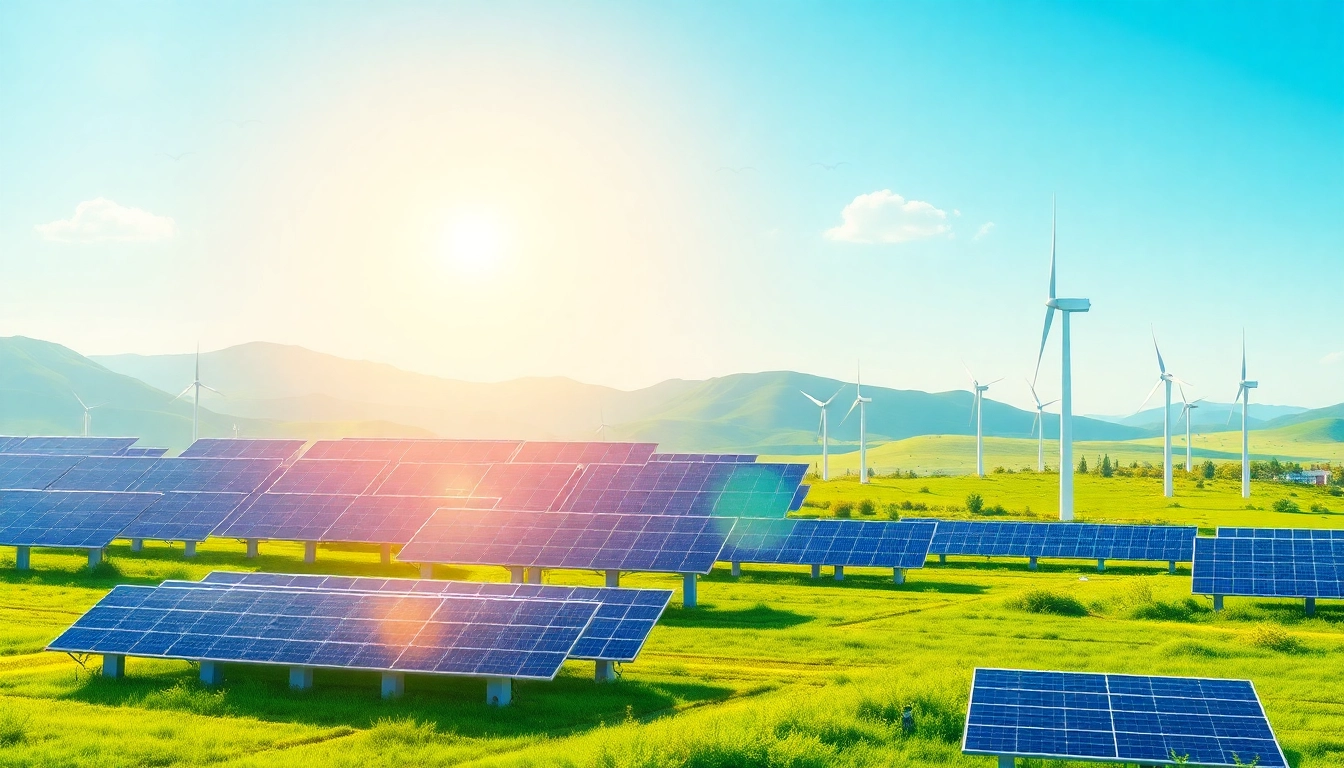Understanding Renewable Energy: Types and Significance
Defining Renewable Energy and Its Global Role
Renewable energy refers to energy harnessed from natural sources that are replenished continuously at a higher rate than they are consumed. These sources include sunlight, wind, water, geothermal heat, and biomass. By tapping into Earth’s natural replenishment cycles, these energy sources offer a sustainable alternative to fossil fuels, which are finite and contribute to environmental degradation. Globally, renewable energy has become a central pillar in combating climate change, reducing greenhouse gas emissions, and ensuring energy security for future generations. According to the United Nations, renewable energy is vital for meeting global climate goals and achieving sustainable development, especially in the face of increasing energy demand and environmental concerns.
renewable energy sources are plentiful, widespread, and inexhaustible, making them essential components of a resilient and sustainable energy system across nations, including India.
Major Types: Solar, Wind, Hydro, Geothermal, and Biomass
The spectrum of renewable energy is diverse, each with unique advantages suited to different geographic and economic contexts:
- Solar Energy: Harnessed through photovoltaic (PV) panels and solar thermal systems, solar power is one of the most rapidly expanding renewable segments, owing to falling costs and technological advancements.
- Wind Energy: Captured via wind turbines, wind power is highly effective in regions with consistent wind streams, contributing significantly to grid-scale power generation.
- Hydropower: Utilizing flowing water to generate electricity, hydropower remains the largest source of renewable electricity worldwide, particularly through large dams and small hydro systems.
- Geothermal Energy: Derived from heat stored beneath Earth’s surface, geothermal is a reliable and stable energy source suitable for base load power, especially in geologically active regions.
- Biomass: Energy produced from organic materials like crop waste, wood, and algae, biomass can be converted into heat, electricity, or biofuels, playing a crucial role in waste management and rural energy needs.
The Environmental and Economic Benefits of Renewable Energy
Transitioning to renewable sources offers substantial environmental advantages, including significant reductions in carbon dioxide and other pollutant emissions, leading to improved air quality and mitigation of climate change. Economically, renewable energy fosters local employment, reduces dependence on imported fossil fuels, and stabilizes energy prices due to the inexhaustible nature of the sources. Additionally, advances in technology have lowered the cost of renewable infrastructure, making it increasingly competitive with conventional energy sources. As India aims to meet 40% of its power needs through renewable sources by 2030, these benefits are critical for fostering sustainable growth and environmental resilience.
Current Trends and Developments in India’s Renewable Energy Sector
Government Policies Accelerating Market Growth
India’s commitment to expanding its renewable energy capacity is reinforced by progressive policies and ambitious targets. In particular, the Ministry of New and Renewable Energy (MNRE) has introduced measures such as the National Solar Mission, wind energy development programs, and hybrid projects to boost capacity expansion. Recent regulatory frameworks, including the adoption of Rajasthan’s Green Open Access (GOA) rules, exemplify the push toward facilitating large-scale renewable projects. Rajasthan, in May 2025, became the first state to mandate battery energy storage systems (BESS) as an integral part of open access projects, thereby enhancing grid stability and enabling higher renewable capacity integration.
Latest Infrastructure Projects and Initiatives
India is witnessing an unprecedented boom in renewable infrastructure. Massive solar parks, wind farms, and hybrid projects are progressing across states such as Gujarat, Tamil Nadu, and Rajasthan. For instance, the integration of battery energy storage systems (BESS) is a groundbreaking development, addressing intermittency issues and facilitating smoother grid operation. The government’s focus on grid modernization, smart meters, and resilient transmission networks complements these projects. Furthermore, upcoming large-scale projects like the Taranga Renewable City and the envisaged offshore wind farms along the Gujarat coast aim to diversify the renewable portfolio and meet the growing demand for clean energy.
Emerging Technologies and Innovations in India
India’s renewable energy landscape is rapidly evolving with innovations such as bifacial solar panels, floating solar installations, and wind-solar hybrid systems. Recent advancements include the development of high-efficiency perovskite solar cells and scalable energy storage solutions, which are vital for reliable power supply. Notably, the application of AI and IoT ensures improved grid management, predictive maintenance, and optimized energy dispatch. The launch of virtual Power Purchase Agreements (PPAs), authorized by the Central Electricity Regulatory Commission (CERC) in May 2025, signifies a major shift towards innovative financial models that promote renewable procurement and liquidity enhancement.
Challenges and Solutions in Scaling Renewable Energy
Grid Integration and Storage Technologies
A primary challenge in India’s transition to renewable energy is integrating variable generation sources into the existing grid infrastructure. Intermittency issues with solar and wind power necessitate advanced storage solutions to maintain grid stability. Energy storage technologies, including large-scale battery systems and pumped hydro, are critical. The evolution of grid-scale energy storage tenders reflects ongoing efforts to build resilient infrastructure. Rajasthan’s mandate for battery energy storage in open access projects indicates a strategic approach to overcoming these hurdles collaboratively.
Policy Barriers and Regulatory Frameworks
Despite progressive policies, regulatory uncertainties and cumbersome approval processes can impede project development. Land acquisition, environmental clearances, and grid connection delays are common issues faced by developers. The introduction of virtual PPAs and flexible open access rules aims to streamline market access and enhance liquidity. Continued policy reform, such as simplifying tariffs and providing incentives for storage integration, is essential to accelerate renewable deployment.
Financing and Investment Opportunities
Funding remains a critical component, with institutions like international lenders, green funds, and private investors increasingly active in the sector. Innovative financial instruments such as virtual PPAs and green bonds are gaining traction. Given the declining costs of renewable tech, the investment landscape is highly favorable, but risks related to policy stability and currency fluctuations must be managed. Enhanced risk assessment tools, comprehensive market intelligence, and strategic collaborations are vital for both domestic and international stakeholders.
Case Studies and Market Outlook for 2024 and Beyond
Successful Projects and Pioneering Companies
Leading companies such as MG Motor and MG Windsor EV exemplify India’s budding electric mobility revolution. MG Motor entered India in 2020, rapidly expanding its EV portfolio with models like the MG WIndsor EV, which is powering India’s shift to cleaner transportation. Additionally, Rajasthan’s Battery Energy Storage projects and innovative open access rules showcase regional leadership in integrating storage with renewables. These case studies demonstrate the importance of strategic planning, regulatory support, and technological innovation for project success.
Forecasting Market Growth and Investment Trends
The renewable energy market in India is projected to grow significantly, with capacity addition targets accelerating towards 2030. The sector is expected to attract over USD 70 billion in investments, driven by falling costs, policy support, and technological innovation. The adoption of virtual PPAs, which facilitate corporate renewable procurement, will play a substantial role. Experts forecast that hybrid systems, including solar-wind and solar-storage combinations, will dominate new capacity deployments in the coming years.
Strategies for Stakeholders to Maximize Impact
To capitalize on this momentum, stakeholders should focus on diversifying project portfolios, leveraging new financing tools, and adopting smart grid technologies. Early engagement with policy reforms and active participation in pilot projects, like Rajasthan’s battery mandates, are essential. Companies should also invest in capacity building, research, and innovation to remain competitive and contribute to India’s renewable goals.
Future Outlook: Achieving India’s 2030 Renewable Energy Goals
Role of Technology and Policy Innovation
Achieving the ambitious target of 500 GW of non-fossil fuel capacity by 2030 hinges on continuous technological advancements, including high-efficiency PV modules, energy storage breakthroughs, and smart grid systems. Policy reforms such as facilitating virtual PPAs, streamlining open access procedures, and incentivizing storage integration will remain pivotal. The deployment of battery energy storage, as seen in Rajasthan, illustrates how policy-driven innovation can enable a reliable and resilient renewable ecosystem.
Public-Private Sector Collaboration
Collaboration between government agencies, private investors, and technology providers is vital for scaling renewable energy. Public-private partnerships will foster innovation, reduce costs, and accelerate project implementation. The success of utility-scale projects and EV adoption, exemplified by MG Windsor EV, underscores the importance of coordinated efforts and strategic alignment with national objectives.
Long-term Benefits for Environment and Economy
Increased renewable energy deployment will drastically cut carbon footprints and improve air quality. Economically, it will generate employment, incentivize domestic manufacturing (particularly in PV modules and storage), and reduce energy import dependence. Long-term benefits also include enhanced energy access for underserved communities and resilience against climate-related disruptions, positioning India as a global leader in clean energy transition.









